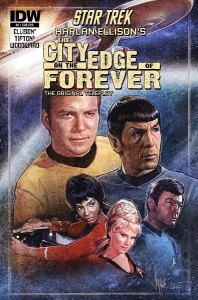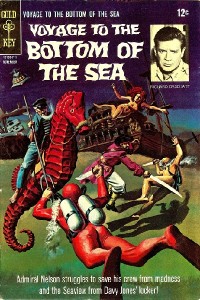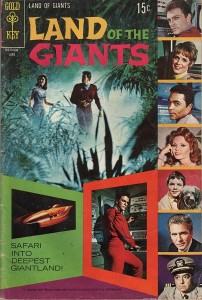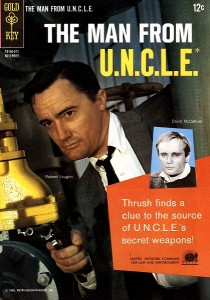 Top 10: Possible Batman ’66 Crossovers by Jerry Whitworth
Top 10: Possible Batman ’66 Crossovers by Jerry Whitworth
Announced at San Diego Comic-Con 2015, DC Comics’ hit digital first series Batman ’66 will crossover with the Avengers from IDW’s Steed and Mrs. Peel. This follows the popular mini-series Batman ’66 Meets The Green Hornet co-produced with Dynamite Entertainment which continued the crossover from the original television series. The author of Wonder Woman ’77 has also commented on a desire to crossover with Batman ’66 (which isn’t new ground as Adam West and Burt Ward returned to their familiar roles with the Justice League of America in 1979’s Legends of the Superheroes). These crossovers may very well be a sign of things to come which prompts the question of what series could we see join the trend down the line. Lets explore some series that could fit in well with the time period and/or tone of Batman ’66.
 10. DARK SHADOWS
10. DARK SHADOWS
The Gothic soap opera Dark Shadows originally started as a traditional soap opera when Victoria Winters became the governess in the wealthy Collins family household as the identity of her birth parents became an ongoing mystery within the show (one never officially solved within the series). Everything changed when Dark Shadows faced cancellation forcing the showrunners to think outside the box leading to the introduction of a vampire. Searching for a believed hidden Collins family treasure, groundskeeper Willie Loomis instead unleashed the vampire Barnabas Collins from his sealed crypt which proved to be a huge hit for the series making it a cultural phenomenon (even spawning feature films based on the soap opera). Barnabas was soon followed by various other creatures of the night such as ghosts, witches, werewolves, and even the devil. The Batman comic book is certainly no stranger to such things, having featured the vampire Mad Monk, Gentleman Ghost, Anthony Lupus, Man-Bat, Solomon Grundy, and more. The 1966 television series, on the other hand, largely avoided such things (save perhaps the supposed witch Aunt Hilda). However, counted among Batman’s rogues gallery is Egghead, portrayed by Horror icon Vincent Price, who can certainly offer a certain wink-and-a-nod to such a story. Further, considering Egghead’s relationship with Olga, Queen of the Cossacks, he certainly seems to have little problem with teaming up with the fairer sex for his schemes. As such, an alliance with witch Angelique Bouchard could very well lead to Batman being forced to align with Barnabas for the fate of the world. Dynamite Entertainment published Dark Shadows comics from 2011 through 2013.
 9. STAR TREK
9. STAR TREK
A redefining series in the history of Americana, Star Trek was Gene Roddenberry’s hopeful view on humanity’s future as a space-faring culture dedicated to peace, acceptance, and exploration. The series was as innovative as it was controversial which made it an enduring phenomenon but saw its initial run as shortlived (lasting only three seasons, a parallel to Batman). During its original late-1960s broadcast, it made its star William Shatner (who portrayed Captain James T. Kirk) a sex symbol known for his scene-chewing dialogue which often times was reminiscent of Adam West’s Bruce Wayne/Batman making the two men, along with Sean Connery’s James Bond, the male sexual icons of the decade. A number of actors from the Batman series found their way onto Star Trek, most notably Frank Gorshin (The Riddler) as Commissioner Bele, Yvonne Craig (Batgirl/Barbara Gordon) as Marta, Roger C. Carmel (Colonel Gumm) as Harcourt Fenton Mudd, and Malachi Throne (False Face) as various characters. Star Trek has been the focus of a number of comic book crossovers especially in recent years and with DC Comics in Star Trek/Legion of Super-Heroes (2011) and, premiering earlier this month, in Star Trek/Green Lantern: The Spectrum War (both from IDW Publishing). Considering the relationship between DC and IDW which includes the aforementioned Star Trek crossovers and the upcoming ones with Batman ’66 and the Avengers and Batman and the Teenage Mutant Ninja Turtles, a Star Trek/Batman ’66 pairing certainly doesn’t seem that far-fetched.
 8. VOYAGE TO THE BOTTOM OF THE SEA
8. VOYAGE TO THE BOTTOM OF THE SEA
Based on a 1961 film of the same name, Voyage to the Bottom of the Sea featured the crew of the USOS Seaview nuclear submarine in the near-future of the 1970s as they faced various threats including monsters, aliens, and spies lasting four seasons from 1964 to 1968. What’s interesting about its connections to Batman is that it shared props with the series (Irwin Allen, who created Voyage, also shared props with his other sci-fi TV series in Lost in Space, The Time Tunnel, and Land of the Giants). Likely the most notable prop both shared was in their respective films. Commodore Lucius Emery in Voyage kept a pet shark which killed a saboteur in the film’s conclusion. That same rubber shark was the infamous shark that latched onto Batman prompting his use of the shark repellent bat spray. Arguably one of the most entertaining episodes of Voyage was “A Time To Die” which introduced Mr. Pem whose pocket-watch time booster controlled time. A story involving Pem and another major clock admirer in Clock King would make for an excellent story. Gold Key produced comics based on the Voyage film and then TV series in the 1960s.
 7. TIME TUNNEL
7. TIME TUNNEL
Alluded to previously, Time Tunnel was a television series created by Irwin Allen in the 1960s which shared props with Batman. The premise of Time Tunnel involved a secret government initiative called Project Tic-Toc dedicated toward time travel that lost doctors Tony Newman and Doug Phillips in time and must try to bring them back to the present. Newman and Phillips go on various adventures in the past and future meeting historical figures, experiencing infamous tragic events, and sparring with aliens. Besides props, Batman also shares a notable actor in Lee Meriwether who portrayed Dr. Ann MacGregor in Time Tunnel and Catwoman in the Batman film. Despite good ratings while being in one of the worst time slots, Time Tunnel was canceled when an executive for ABC wanted to produce a series on historical figure George Custer instead (which was canceled after three months following protests from Native Americans). Gold Key would produce two comic books based on Time Tunnel.
 6. FANTASTIC VOYAGE
6. FANTASTIC VOYAGE
A 1966 sci-fi film, Fantastic Voyage featured a scientist nearly killed by an assassin that must be saved by a medical team that shrinks to microscopic size to enter his body. The plot of the film has been paid homage and parodied repeatedly for decades, even to today (several times even in the DC Universe). Fantastic Voyage would premier at box office a month after Batman hit movie theaters. Both featured some rather questionable depictions of science, even for sci-fi, which could see a fairly easy transition should the two properties meet. What more, it leaves the door open for what Bat-villains could be included, even an obscure one like Killer Moth. Although, the use of a saboteur in the film could make someone like False Face a good pick (albeit the character became Clayface in the Batman ’66 series). Gold Key Comics would adapt for print an animated series from Filmation based on the film.
 5. LAND OF THE GIANTS
5. LAND OF THE GIANTS
Another 1960s sci-fi TV series from Irwin Allen that shared props with Batman, Land of the Giants was set in the near-future of the 1980s where passengers aboard the spaceship Spindrift are marooned on a planet that parallels Earth but with everything many times larger in size. Similar in some respect to Gilligan’s Island but with a much higher degree of danger, several instances occurred where the passengers could have returned to Earth but chose otherwise to prevent the alien world’s inhabitants from following (where it was likely they could easily conquer Earth despite being less advanced in certain areas of science). Certainly, Land of the Giants calls to mind the fairy tale of “Jack and the Beanstalk” where a magic harp calms the giant Jack wishes to steal from in order to save his family estate. Elements of this could be played up if, by some series of events, Batman’s enemy the Siren arrived on the giant’s planet and enslaved its males in her service. It would be a trial of immeasurable difficulty for Batman to face. Gold Key would briefly produce a comic series based on Land of the Giants.
 4. LOST IN SPACE
4. LOST IN SPACE
A popular television show in the 1960s, Lost in Space was another sci-fi series from Irwin Allen which shared props with Batman. Therein in the near-future of the 1990s, the spaceship Jupiter 2 left Earth with the Robinson family in hopes of colonizing a planet near Alpha Centauri. Everything changed when a foreign spy in Dr. Zachary Smith tried to sabotage the mission only to trap himself aboard and set the vessel hopelessly off-course in the expanse of uncharted space (despite his villainous origins, Smith would actually come to care for the Robinson family). The fate of the crew was left unknown when the series was mysteriously canceled after three seasons, the reasons of which may never be known as production had already began on a fourth season when the decision came down from executives (likely the closest answer that will ever be known was while the show continued to grow in popularity with children, it declined among older viewers that advertisers preferred). In 1966, Lost in Space and Batman were in direct competition with each other sharing the same timeslot on separate networks which likely led to the former’s more campier turn in order to combat its competitor. The Jupiter 2 had a saucer design to it where in the Batman episode “The Joker’s Flying Saucer,” the Joker builds an operational flying saucer (that seems to borrow some notes from the TARDIS by being significantly larger on the inside than out) to ransom Gotham with or face a supposed Martian invasion. If the Joker was able to employ such an apparatus to go into space it wouldn’t then be too challenging to conceive how it could go into the future in the time of Lost in Space. Gold Key would produce a comic series predating Lost in Space with a similar concept in Space Family Robinson (in fact, after the TV show premiered, Gold Key won a court battle that allowed them to add “Lost in Space” to their comic’s title). The first official comic adaptation of Lost in Space came in 1991 from Innovation Comics written by Bill Mumy (who played Will Robinson in the series).
 3. THE MAN FROM U.N.C.L.E.
3. THE MAN FROM U.N.C.L.E.
An international criminal organization of such high capability that its existence threatened the freedom of the very world itself in T.H.R.U.S.H., the governments of Earth (even those in opposition) were forced to cooperate and form a borderless law agency to defeat them. The agency would be U.N.C.L.E. and its top operatives would be American Napoleon Solo and USSR-Georgian Illya Kuryakin who trotted the globe combating T.H.R.U.S.H. where ever it reared its ugly head. The Man from U.N.C.L.E. premiered in 1964 and would run for four seasons and acquired in its third season writer Stanley Ralph Ross who was best known for his extensive work on Batman (he also helped develop Wonder Woman for her TV series). Beginning with its second season, U.N.C.L.E. began to emulate the parody nature of Batman to entice its audience (however, the show was popular since its first season, such that it spawned many several spy shows). The move ultimately would be its undoing as the ratings dropped the sillier it became. Yvonne Craig (Batgirl/Barbara Gordon on Batman) would emerge in the series playing three separate characters. A villain that could work exceedingly well in the world of The Man from U.N.C.L.E. would be Minerva who used a health spa as a means of extracting secrets from its wealthy patrons. Gold Key would produce The Man from U.N.C.L.E. comics in the ’60s but the series would be adapted by several publishers over the decades.
 2. THE WILD WILD WEST
2. THE WILD WILD WEST
In a bid to combine the popularity of James Bond with the waning market of the American Western, The Wild Wild West featured two former soldiers in the American Civil War who became the premier operatives for the Secret Service protecting the President of the United States and the country itself. Man of action James T. West would combine his martial art skills and cache of innovative gadgets with Artemus Gordon, master of disguise and brilliant inventor, to combat villains like the diminutive Dr. Miguelito Quixote Loveless whose brilliant mind was only matched by his monstrous schemes. While Loveless was by far the nemesis of West and Gordon, Count Carlos Mario Vincenzo Robespierre Manzeppi was arguably their second greatest reoccurring foe who employed illusion to mask assassinations. What’s interesting is Manzeppi was portrayed by Victor Buono, who would play several different characters on Wild Wild West, an actor arguably best known for his portrayal of King Tut on Batman. The Western spy series would employ several Batman actors notably including Yvonne Craig as the assassin Ecstasy La Joie. The parallels in design and structure between the two shows was rather dazzling, where many of the plots could easily be interchangeable with each other (though, Wild Wild West often focused around murder more directly than Batman). Quite honestly, a Bat-Locomotive alone could be a selling point for making this crossover a reality. The Wild Wild West was canceled after four seasons because it was deemed too violent (though, it would spawn two TV movies and a feature film). Two comic adaptations would be produced based on the series, first by Gold Key and then decades later by Millennium Publications (the publisher also produced a The Man from U.N.C.L.E. series).
 1. THE MONKEES
1. THE MONKEES
At first glance a seemingly bizarre selection especially at the top of a Top 10 list, but a villain from Batman would actually make a cameo in The Monkees. Intended originally as a comedic parody of the Beatles, The Monkees became its own separate phenomenon spawning a hit television series and a string of music hits. Sadly, the series would collapse under its own fame after two seasons as its stars wanted to move away from its manufactured sound toward something more heartfelt which didn’t connect with fans. The show followed the misadventures of the quartet band the Monkees as they were striving toward their big break and the zany antics that journey would entail. The series would feature a Monkeemobile designed and built by Dean Jeffries, an auto fabricator that was originally tasked with making the Batmobile for Batman before a change in the show’s schedule forced him to abandon the job to his chief bitter rival George Barris (Barris would later buy one of the two Monkeemobiles Jeffries produced and tour with it alongside the Batmobile). Jeffries would also design and build the Black Beauty for The Green Hornet. The Penguin would make a brief cameo on The Monkees following his final appearance on Batman and just prior to the airing of Batman‘s series finale. He was seated at a table watching a performance of the Great Oracullo at the Club Cassandra squawking out his signature laugh. While certainly a wink-and-a-nod to viewers, the mystery of Penguin’s appearance was never addressed in any subsequent stories. Dell Comics would adapt The Monkees for the four-color page in the late ’60s. At one point in the comic, the band became the costumed Monkeemen (or, Supermonkees) who would make a cameo in the comic series Kingdom Come.
Honorable mentions: Doctor Who, Planet of the Apes, Derek Flint, Mork & Mindy, and Six Million Dollar Man.



They have already crossed over with The Man from U.N.C.L.E.
This was written seven months ago.
I would love a Get Smart crossover
I would like to see a Star Trek TOS, Twilight Zone, or Superman ’55 crossover. However, I’m open with the idea of a classic Doctor Who, or Get Smart crossover.